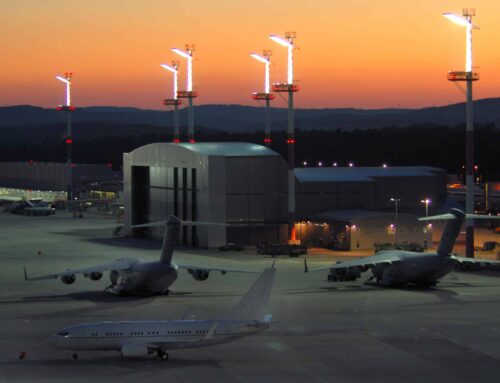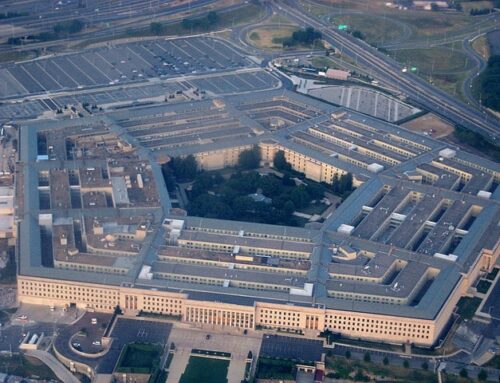Despite plans to operate the F-35 through 2088, the Air Force and Navy are now working to develop sixth-generation fighters along with Collaborative Combat Aircraft (CCAs), autonomous drones that can tether to fighters or perform missions independently, all of which they plan to field in the 2030s. (August Clawson/U.S. Navy)
In 2005, the projected cost of the fifth-generation F-35 Joint Strike Fighter program was about $950 billion adjusted for inflation over the course of its life cycle. Nearly two decades later, the F-35 is projected to cost taxpayers over $2 trillion. It’s the most expensive weapon system ever built — for now. Adding operational insult to fiscal injury, the aircraft is only able to perform all of its missions about 30% of the time.
Despite plans to operate the F-35 through 2088, the Air Force and Navy are now working to develop sixth-generation fighters along with Collaborative Combat Aircraft (CCAs), autonomous drones that can tether to fighters or perform missions independently, all of which they plan to field in the 2030s.
If Congress hopes to avoid saddling taxpayers with another multitrillion-dollar generation of underperforming fighter aircraft, it needs to get serious about oversight, and quick.
According to a new report by Taxpayers for Common Sense (where I am a policy analyst), while the Pentagon is pursuing some steps to avoid the mistakes of the F-35, it still risks repeating many of those mistakes, and also faces new risks.
One of the major drivers of cost growth, schedule delays, and performance issues for the F-35 was a high level of overlap between development and production, a practice known as concurrency. While this may have gotten the first F-35 off the ground sooner, as designs advanced, problems surfaced, necessitating upgrades that fueled cost growth and sustainment challenges across the fleet. These problems persist to this day, evidenced most recently by F-35s gathering dust as they wait for a new suite of technology upgrades that are proving tricker than anticipated.
For the sixth-generation fighter, rather than avoiding concurrency altogether, Air Force Secretary Frank Kendall has simply said there will be less of it, promising it will happen “in a rational way, that doesn’t take excessive risk.” He didn’t elaborate on what he views as rational or what level of risk he’d find acceptable.
Another source of cost growth and underperformance in the F-35 was its overloaded mission set. On top of everything else it was tasked with, from air-to-air combat to air-to-ground attacks to stealth and reconnaissance, the Air Force gave the F-35 a close-air-support mission so that it could save funds by retiring the A-10. But in comparison tests between the F-35A and the A-10C, the F-35 fell flat, requiring more sorties to hit the same number of targets with less accuracy. This relative underperformance, paired with the F-35’s production delays, helps explain why Congress routinely prohibits the retirement of A-10s in annual policy bills. As a result, we’re now paying for two planes to carry out one mission.
Pentagon leaders may be making a similar mistake with sixth-generation fighters. For one, while the Air Force’s sixth-generation fighter was originally meant to replace the F-22, Air Force officials now say they are “planning several upgrades to the (F-22) jet as we speak, and there is no official replacement to the F-22 right now.”
Moreover, the strategic rationale for building sixth-generation fighters rests on the assumptions that we need to be able to project air superiority deep into enemy territory, and that we need a fighter capable of destroying targets deep in enemy territory. But air superiority is largely about protecting friendly forces on the ground, and ground-based air defenses paired with current-generation fighters might be enough to get the job done. As for hitting targets deep in enemy territory, long-range precision fires and stand-off cruise missiles that can be launched from outside enemy air defenses may offer the same capability at a lower cost.
As for next-generation risks, there are obviously serious concerns associated with deploying artificial intelligence on weapons platforms. Aside from the high risk of cost growth associated with fielding new technologies, AI’s ability to dramatically expand target lists by rapidly sorting through massive amounts of data could in turn dramatically expand the scope of a conflict. Cybersecurity risks associated with autonomous platforms also abound.
Then there are the Pentagon’s sweeping modernization plans, which are proving to be financially unviable in light of growing costs. For example, the Air Force’s Sentinel program, which aims to build a new generation of nuclear intercontinental ballistic missiles, is now a staggering 81% over budget compared to projections made in 2020. This is likely what led Kendall to admit that in the five-year spending plan the Air Force submitted to Congress, “it’s clear we did something there that’s not going to be, you know, sustainable.”
That this cost explosion coincided with a slew of Air Force statements questioning their own plans for the sixth-generation fighter is probably not a coincidence. While Pentagon officials like Kendall deserve some credit for rethinking their plans in light of fiscal constraints, there’s little indication that the services are revisiting the underlying strategic rationale for the sixth-generation fighter. Congress should insist that they do.
Lawmakers are struggling to address the challenges facing the F-35 in part because a lot of the damage is already done. But with the sixth-generation fighter, Congress has a chance to offer some preventative care that might save taxpayers from a new generation of aircraft that doesn’t deliver for the American people.
Lawmakers can start by requiring the Air Force and Navy to conduct new analyses of alternatives. These should include comparisons of options for manned and unmanned fighter aircraft, as well as potential alternatives for meeting strategic needs without a sixth-generation fighter at all. In the meantime, Congress should pause funding for these programs rather than forging ahead with development contracts for programs that may need to be overhauled, if they need to move forward at all.
The F-35 is a cautionary tale. The Pentagon is arguably trying to learn from it. Congress should too. Pumping the brakes on the sixth-generation fighter is a logical place to start.











Get Social